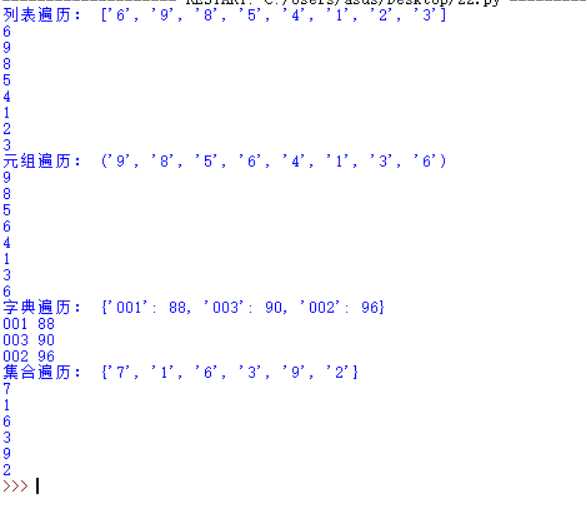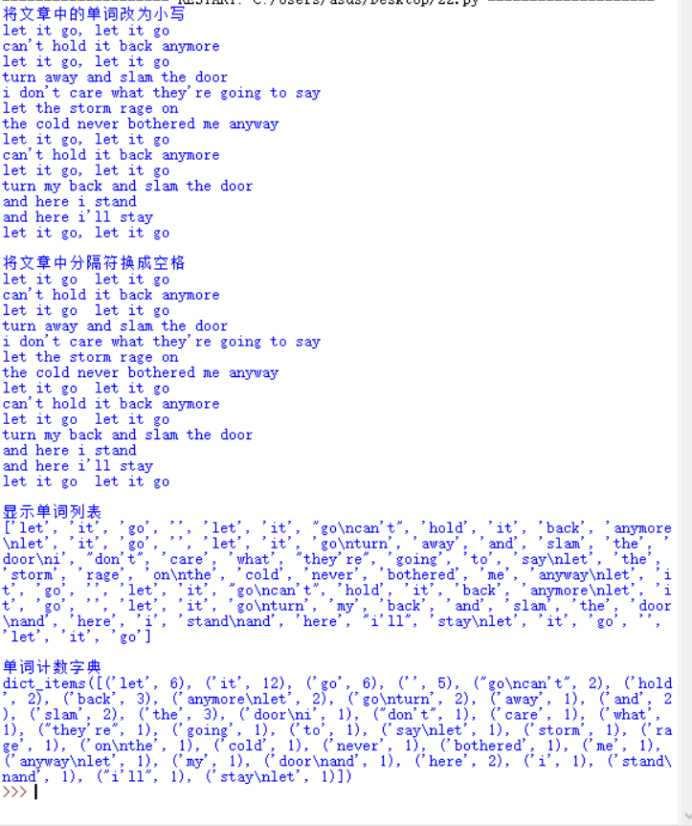标签:color 分片 键值 支持 png ack 生成 转换 逗号
dict={‘01‘:90,‘02‘:85,‘03‘:82,‘04‘:83,‘05‘:96,‘06‘:85,‘07‘:88,‘08‘:76,‘09‘:92,‘10‘:78}
print(‘学生学号成绩:‘,dict)
dict[‘05‘]=92
print(‘增加学号为11的学生的成绩为90:‘,dict)
dict.pop(‘06‘)
print(‘删除学号为06的学生成绩:‘,dict)
print(‘查找学号为08的学生成绩:‘,dict.get(‘08‘))
print(‘查找12的学生成绩:‘,dict.get(‘12‘,‘没有该学生‘))
dict[‘01‘]=77
print(‘修改学号为01的学生成绩为77‘,dict)
print(‘遍历:‘)
for i in dict:
print(i,dict[i])

2.列表,元组,字典,集合的遍历。
总结列表,元组,字典,集合的联系与区别
a=list(‘69854123‘) print("列表遍历:",a) for i in a: print(i) b=tuple(‘98564136‘) print("元组遍历:",b) for i in b: print(i) id={‘001‘,‘002‘,‘003‘} scores={90,88,96} c=dict(zip(id,scores)) print("字典遍历:",c) for i in c: print(i,c[i]) d=set(‘671239‘) print("集合遍历:",d) for i in d: print(i)

答:区别是:列表:可重复,没有长度的限制,元素类型可不同,可以随时增加和删除其中的元素;
元组:是不可以变的。即一旦被赋值,值就不能进行增加,删除和修改;
字典:是用来存储键值对数据。用大括号,每一组用冒号连起来,然后各组用逗号隔开,可以通过键来查找值,字典是无序的。
集合:集合里面的元素不能重复,通过一个set函数转换成集合,集合是无序的,所以不支持 索引, 分片。
列表是以[ ]形式表示,元组是以( )表示,字典以{ }表示,集合则是以[()]的形式表示。
3.英文词频统计实例
3.单词计数字典
g=‘‘‘Let it go, let it go Can‘t hold it back anymore Let it go, let it go Turn away and slam the door I don‘t care what they‘re going to say Let the storm rage on The cold never bothered me anyway Let it go, let it go Can‘t hold it back anymore Let it go, let it go Turn my back and slam the door And here I stand And here I‘ll stay Let it go, let it go‘‘‘ print(‘将文章中的单词改为小写‘) g=g.lower() print(g,‘\n‘) print(‘将文章中分隔符换成空格‘) for i in ‘,.!‘: g=g.replace(i,‘ ‘) print(g,‘\n‘) print(‘显示单词列表‘) words=g.split(‘ ‘) print(words,‘\n‘) print(‘单词计数字典‘) dic={} for i in words: dic[i]=words.count(i) a=dic.items() print(a)

标签:color 分片 键值 支持 png ack 生成 转换 逗号
原文地址:http://www.cnblogs.com/222ya/p/7597955.html